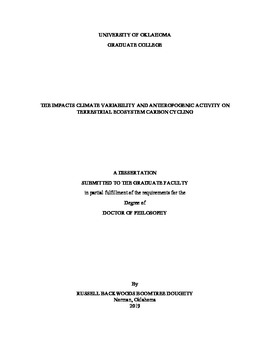| dc.description.abstract | There is a near consensus among climate scientists that global temperatures are rising, climate variability will increase, and climate extremes will become more extreme. What is debated, however, is how terrestrial ecosystems and croplands will respond to these predicted changes in climate. The global carbon flux budget is largely driven by terrestrial photosynthesis and croplands are the foundation of global food security. Thus, the impact of changes in climate on terrestrial ecosystems and croplands has received considerable attention in recent decades. My overall objective was to identify how drought and pluvial events affect croplands in Oklahoma and the Amazon rainforest so that these responses can be incorporated into earth system models that simulate the impact on and feedbacks between climate and vegetation.
In this study, I hypothesized that the responses of grassland, winter wheat (Triticum aestivum L.), other C3 cropland, and C4 cropland to drought and pluvial events are largely determined by their respective photosynthetic pathway and landowners’ ability or inability to irrigate. The specific objective was to analyze the response of gross primary production (GPP) for irrigated and non-irrigated grasslands, winter wheat, other C3 croplands, and C4 croplands in Caddo County, Oklahoma to the 2011 drought and pluvial 2015. For this analysis, we used four datasets each year from 2010 to 2016: (1) satellite-based GPP data from the Vegetation Photosynthesis Model (GPPVPM) (Jin et al. 2015; Zhang et al. 2017a); (2) the MODIS GPP product (GPPMOD17) (Running and Zhao 2015); (3) the Cropland Data Layer (CDL); and (4) irrigation permit data from the Oklahoma Water Resources Board (OWRB). Our analysis included three main steps: (1) compare GPP estimates at three eddy flux towers (GPPEC) placed in sites with native grassland, old world bluestem pasture (Bothriochloa caucasica C.E. Hubb.), and winter wheat in El Reno, Oklahoma, with GPPVPM and GPPMOD17; (2) compare 8-day, intra-annual GPPVPM estimates in 2011, 2013, and 2015 for eight 500 m pixels, one each for irrigation-permitted and non-permitted grasslands, winter wheat, other C3 croplands, and C4 croplands in Caddo County; and (3) analyze the responses of each land cover type at the county scale to the 2011 drought and pluvial 2015.
I also sought to advance our scientific knowledge on how the Amazon rainforest responded to extreme climate events. I used monthly SIF data from GOME-2 and OCO-2, gross primary production estimates from the Vegetation Photosynthesis Model (GPPVPM), and MODIS-based vegetation indices for 2007-2017 to investigate 1) to what degree were the seasonality of SIF, photosynthesis, and greenness of moist tropical forests consistent with each other, and 2) how did dry-season SIF, photosynthesis, and greenness change during the strong El Niño (2010 and 2016) and La Niña years (2008 and 2011). I hypothesized that the forested Amazonian sites have increased SIF, photosynthesis, and greenness during the dry-season, and that dry-season SIF, productivity, and greenness are enhanced during the two El Niño years but reduced during the two La Niña years. The rationale is that leaf flush and phenology drive the dry-season greening of the moist tropical Amazon forest and that productivity will be enhanced in drier dry seasons due to increased sunlight and a lack of water limitation. To further investigate the seasonality of SIF in the Amazon, I also analyzed SIF data from the TROPOspheric Monitoring Instrument (TROPOMI), which launched in October 2017. The data from the satellite, also called the Sentinel-5 Precursor, has a spatio-temporal resolution of 3.5 km by 7 km with near-daily global coverage. I also conducted a global comparison of SIF with GPP and vegetation indices to investigate if SIF better captures vegetation dynamics in some regions on Earth, and to determine which vegetation index best agrees with SIF in space and time. | en_US |
